#church of st nicholas and st mary
Explore tagged Tumblr posts
Text
The woman portrayed as very small, Elizabeth Etchingham, died first, in 1452, nearly 30 years before her friend Agnes Oxenbridge, who died in 1480.
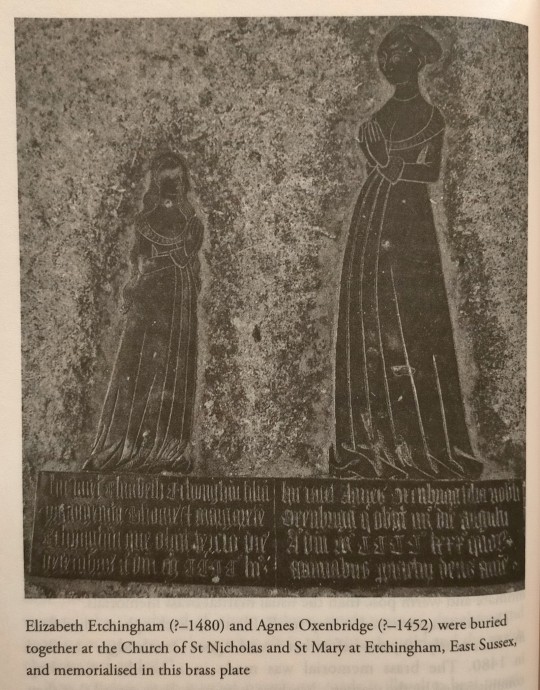
"Normal Women: 900 Years of Making History" - Philippa Gregory
#book quote#normal women#philippa gregory#nonfiction#elizabeth etchingham#death#50s#1450s#agnes oxenbridge#80s#1480s#15th century#and they were roommates#lesbian#church of st nicholas and st mary
0 notes
Text
A rare medieval example of the recognition and celebration of a loving partnership between two women can be seen in the Church of St Nicholas and St Mary at Etchingham in East Sussex.
"Normal Women: 900 Years of Making History" - Philippa Gregory
#book quotes#normal women#philippa gregory#nonfiction#recognition#celebration#loving#partnership#lesbian#church of st nicholas and st mary#st nicholas#st mary#etchingham#east sussex#memorial#elizabeth etchingham#agnes oxenbridge
0 notes
Text
every now and again I think about Eleanor Cobham is buried somewhere in Beaumaris and get really sad about how no one knows where (and that no one but me and maybe 3 other people care).
#there was a fair bit of folklore about her on the isle of man but now it's known she didn't die there it seems to be dropped entirely#and there's. nothing. about her at beaumaris#eleanor cobham#blog#the general consensus from the few who do talk about it seems to be at st mary's and st nicholas's church at beaumaris#but there's no memorial or indication where she might be buried there#given she was buried with 'great cost' (100 marks) it seems like she'd be buried in a high status location#i have wondered if she's in the same vault as sir william beauchamp and his wife elizabeth braybrooke (who were her jailors)#or at least nearby#or in the chapel at beaumaris castle but honestly it seems so strange
4 notes
·
View notes
Text
Tallinn
Tallinn was a pleasant surprise, more enjoyable perhaps than Helsinki, from where I caught a ferry across the Baltic Sea to Estonia. Tallinn is by far the largest city in Estonia, but it is a small country. It had a lovely old town but the new town was also surprisingly attractive in places, and home to two incredible museums. Lennusadam is part of the Estonian Maritime Museum, and is probably…

View On WordPress
#Alexander Nevsky Cathedral#Danish King&039;s Garden#Estonia#Great Coastal Gate#Kohtuotsa viewing area platform#Lennusadam#Long Leg Gate Tower#Maarjamäe Castle Estonian History Museum#Patkuli viewing platform#photography#Piiskopi viewing platform#St Mary&039;s Cathedral#St Olaf&039;s Church#St. Nicholas Church and Museum#Tallinn#Tallinn City Hall#Toompea Castle#travel#Viru Gates
0 notes
Note
How do you think explaining Christmas would go down with the boys? I'm specifically looking at Krampus, cause the holiday is all about joy and hope and lights and and giving, and then there's just this half goat demon man that will stuff you in a sack and torture you for Your Sins.
The story of Krampus is actually really metal tbh. There was this evil butcher that killed, chopped, and salted these three kids that were hanging outside his shop, and then St. Nicholas came along and uses the Power Of God to commit actual fucking necromancy to bring the kids back to life. God then cursed this butcher to follow around St. Nich as a punisher that comes around every December 5. The French call him "the whipping father" it's fucking insane actually.
Some of the holiday is also a little weird when you put it into perspective, like: oh yeah, there's this red guy that you write letters to and then he breaks into your house and you leave an offering of milk and cookies for him in exchange for candy and gifts :D! He also has flying reindeer with very cute names btw! But we're not going to talk about that actually cause now we have to decorate this whole ass pine tree that I brought into ramshackle :D it's gonna be great! :D
Bro imagine giving them advent calendars! Those little ones with the small toys or chocolates- give one to Riddle he needs one. Lots of sugar intake to catch up on
🦩
To be real, I was raised very Catholic (ew) and traditionally Mexican so my Christmas stuff is very different from what you see on TV and like in Hallmark movies.
So like, we celebrated it as a religious holiday, so the Santa stuff is kinnda foreign to me, I only heard about it from school. We still got presents and stuff, but I remember doing Posadas, which is children reenacting the Mary and Joseph seeking shelter by going to houses and singing and asking for shelter. At the end we go to one of the parents' houses or to the church and have a little party! We also didn't really decorate like I've seen in American homes, we had like a cute tree usually, but mostly decorated the altars to La Virgen and the Nativity scene.
The biggest difference I've found is that we celebrated Christmas on Christmas Eve instead; we had Nochebuena, so we'd go to midnight mass, have dinner, and at midnight we open presents. Technically, kids didn't get presents because of Santa or anything like that, we got it cause kids get gifts like how the three kings gave baby Jesus presents. Though that also is a different winter holiday in January or February, not sure. When I got older my family started getting more Americanized, and my brothers got the whole Santa deal, but we still did a lot of the church stuff.
Considering that there is no mention of any sort of religious institution in Twisted Wonderland, I imagine my explanation of Christmas would be very foreign. Though Noble Bell College basically being Notre Dame in the Masquerade event and Rollo practically inventing Catholic guilt in a world without Catholics has some implications? I actually don't think there is any mention of any deities that the cast or world in general worship, though perhaps it's implied with Hades? He's not referred to as God of the Underworld though, he's King so maybe??
This got off-topic, but I like to think any explanation of traditions from back home is fascinating to the boys! And there's a lot of winter holidays besides Christmas and Las Posadas, I mean Hanukkah is big and Yule is reemerging as people learn more about where traditions from Christmas comes from.
If you're like me and have a religious aspect to your winter holidays, I think they're curious about it and asking all sorts of questions! If you had the more traditional American Christmas, then they're super curious about the whole Santa deal! Like, they thought you said your world didn't have magic, so what's with this magically man in a red suit and white beard?
(Also, I don't know what advent calendars are, they have candy I'm guessing? If it's a calendar, then I'm safe to assume it's like a count-down to Christmas day?)
#mochi asks#🦩 anon#twst#twisted wonderland#to be fr i thought christmas like on tv was make believe#like it was all disney show or hallmark and that real christmases was way more toned down#you can also imagine my confusion when i first watched the grinch as a kid
50 notes
·
View notes
Text
In Honor of All Saints Day, Here's Some Random Assumptions About My Followers Based on Their Favorite Saints 😇
Please note this is a merely for fun and not meant to offend anyone, please be kind, thank you. Also, I obviously can't possibly include every saint here, so I'm just gonna stick to some of the ones I think are most likely to be favorites of my followers.
Saint Joan of Arc- I'll start with arguably the most popular one, or at least the one I see posted or discussed online the most. If your favorite saint is St. Joan of Arc, there's a good chance you're an atheist who doesn't vibe with saints in general, but likes her because she's a girl with a sword and that's objectively awesome. You're correct for that, and welcome to the post. Another option is that you're a girl who was labeled a "tomboy" growing up.
Saint Paul- if your favorite saint is St. Paul, you have a blog or a significant portion of your blog dedicated to one ex-villain character whose redemption arc you could rewatch on loop for hours. You also might be Protestant, and yes, this particular St. Paul is the same Paul from the Bible. Welcome to the post. ✝️
Saint Olga- if your favorite saint is St. Olga, you support women's rights, but more importantly, you forgive women's wrongs. There have been several times when you've gotten upset about people questioning the validity of a female character's redemption considering her past when they overlook and forgive way worse done by male characters. There's also a chance you might be Orthodox. Welcome to the post. ☦️
Saint Nicholas- if your favorite saint is St. Nicholas, there is a chance you followed me for TMBS content. Your favorite holiday is Christmas, and you're still hyperfixated on the same book series or television show from your childhood. You're also extremely passionate about your fandoms and can't stand it when people grossly misinterpret characters or things in canon.
Saint Benedict- if your favorite saint is St. Benedict, you also probably followed me for TMBS content. You're also a very humble and unproblematic person but the haters are bitter and always trying to bring you down (via their jealousy and also poison, but you can't be stopped).
Saint Scholastica- if your favorite saint is St. Scholastica, you also might have followed me for TMBS content because you know that she's Benedict's twin sister. You also wish that God would summon storms for you whenever you find your brother annoying.
The Virgin Mary, Mother of Jesus- if you picked the Virgin Mary, you're neurodivergent, specifically the type of neurodivergent who loved those card games where characters had different levels of power. You take a similar approach to picking your favorite saint, so why wouldn't you go straight for the one that is objectively the most powerful and the best one? It just makes to most sense to you, and the thing is, you're right. You're 100% right. Congrats!
Saint Cecilia- if your favorite saint is St. Cecilia, you're a musician and were in choir either at school or church. You also probably are/were a theater kid.
Saint Lawrence- if your favorite saint is St. Lawrence, you were definitely a theater kid and tried stand up comedy at least once. You also use jokes and humor to cope with stressful situations.
Saint Josephine Bakhita- if your favorite saint is St. Josephine, you are one of those people who somehow remains positive and sees the sliver lining in literally any circumstance. Don't get me wrong, I love that for you, but please take care of yourself. 🫂❤️🩹
Saint Dymphna- if your favorite saint is St. Dymphna, you are neurodivergent, have struggled with mental illness, work in psychiatric or medical care, or you’ve dealt with a lot in your life, and I hope you heal. 🫂❤️🩹
Saint Kateri Tekakwitha- if your favorite saint is Saint Kateri, you're sick of your relatives pressuring you to date someone, and you're extremely worried about climate change (girl, me too).
Saint Anthony- if your favorite saint is St. Anthony, you have ADHD and lose things multiple times a week. On the off chance you followed me for Wolf359 content, you identified way too strongly with Doug Eiffel.
Saint Peter- if your favorite saint is saint Peter, you either watch "The Chosen" or you have ADHD and felt seen when you read about him in the Bible. That man boldly declared he would never deny Jesus and when told he would do it before a rooster crowed three times, to which he confidently replied "nah" and then immediately got distracted and preoccupied with cutting some guy's ear off and forgot all about the oddly specific terrible thing he was prophesied to do just a few hours earlier by a man he believed to be God incarnate. As someone who also breaks down in tears when I suddenly remember the important things I forget to keep track of, I sympathize with his story. Saint Dymphna is patroness of most mental illness and ADHD is technically covered by her, but if we ever get an ADHD specific saint, I know it has to be either be Peter or Anthony, and if it were entirely up to me, I'd give it to Peter. Don't get me wrong, Saint Anthony is there for us, but Saint Peter is one of us, you know what I mean? Though I feel like due to the problematic nature of diagnosing the deceased (no matter how evident symptoms might be) it would end up going to Anthony, since we do call on him often, and I think Peter would be fine with that.
Saint Mark Ji Tianxiang- if your favorite saint is St. Mark Ji Tianxiang, you or someone you know is probably in recovery from addiction, and I wish you well on your journey. You also empathize way too much with any character who suffers from addiction and if you followed me for Wolf359, that was the aspect of Doug Eiffel's character that stood out to you the most. 🫂❤️🩹
Saint Catherine of Siena- if your favorite saint is Saint Catherine of Siena, you've probably written a book or fanfic well over 100k words. (Yes, I know, you don't have to say it).
Saint Francis of Assisi- if your favorite saint is Saint Francis of Assisi, you either have pets or want them, and if you do have them, you've taken them or begged your parents to let you take them to a St. Francis feast day pet blessing. If you followed me for TMBS, SQ is probably your favorite character, and if you followed me for Wolf359 content, you were inconsolable when Blessie died. You're also probably the kind of neurodivergent who takes things like "if you want to follow God, sell all you have and give it to the poor" literally and as a result, this has caused conflict with your family (specifically on account of you giving all the money made from your family business to the poor).
Saint Joseph- I doubt I have a lot of followers who are parents because of how tumblr demographics skew, but if your favorite saint is Saint Joseph, you just became a dad or really want to become one someday.
Saint Monica- again, I doubt this is the case because of the age of tumblr demographics, but if your favorite saint is Saint Monica, you're a mom who really needs a break, and I hope your husband and sons get it together soon. 🫂❤️🩹
Saint Augustine- if your favorite saint is St. Augustine, you also like redemption arcs and likely went through a "party phase" at some point in your life that you regret and identify a bit too strongly with the younger brother in the prodigal son parable. However, in this case, you likely also love St. Monica and if you followed me for Star Wars content, you are particularly upset that we didn't get to see more interactions between Leia Organa and her son Benny Solo especially considering they led a whole war against each other the year between TLJ and TROS (dead horse, I know).
Saint Juan Diego Cuauhtlatoatzin- if your favorite saint is St. Juan Diego, you have or grew up with a picture of Our Lady of Guadalupe somewhere in your house. You've also been in the incredibly specific situation of seeing or doing something super cool, but not having anyone believe you (but the satisfying payoff when they find out you were right).
Saint Mary Magdalene- if your favorite saint is St. Mary Magdalene, you either watch "The Chosen" or you're a woman who's faith pulled her out of a very difficult time in her life, and like St. Juan Diego, you also know what it's like to be proven right after a group of men call you a liar.
Saints Louis Martin and Marie-Azélie Guérin (Zélie)- if these are your favorite saints, you understand why you can't just pick one. This power couple comes in a set. If you picked these two, you heard about them because your favorite saint might actually be or have been their very famous daughter St. Thérèse of Lisieux. And if you're a guy and you picked these two, you're also a proud girl dad and can't stop bragging to everyone you meet about how successful your wife's business is (especially because she's so humble about it). Green flags all around.
Saint Maximilian Kolbe- if St. Maximilian is your favorite saint, you're a history guy or gal who is obsessed with world war two, but in a good way. In the "this was very not cool. Let's never forget so we never do this again" way. You also love stories of heroic sacrifice and aspire to always do the right thing even when it’s not socially popular or doesn’t benefit you.
(Soon to be canonized) Saint Carlo Acutis- You're a millennial or gen z who loves researching and talking about modern saints. You aspire to be like them and have a list of ones you want canonized (mine are Servant of God Dorothy Day and Archbishop Joseph Francis Rummel. They lived in the 20th Century and when you're dealing with 2,000 years of history, that's pretty modern).
I'm sure I'll think of more to add after I post this, but I'll leave it here for now. I hope y'all enjoy this!
#Happy All Saints Day!#Catholic#Catholicism#Catholic saints#roman catholic#saints#christianity#all saints#all saints day
28 notes
·
View notes
Text
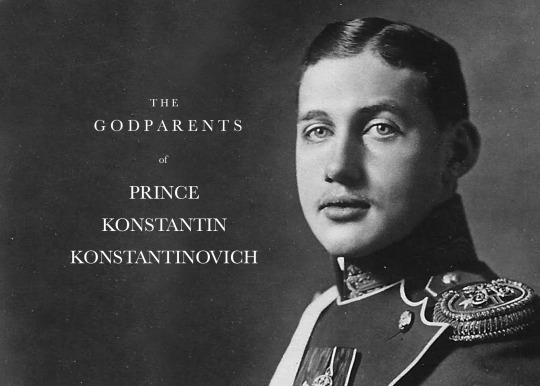
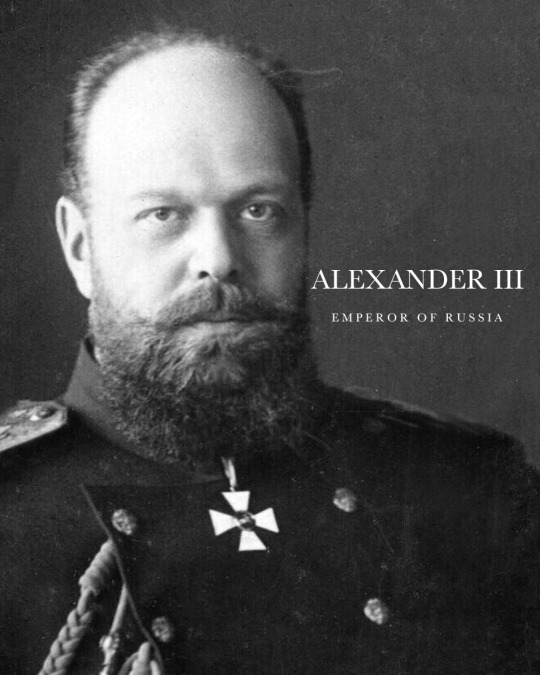




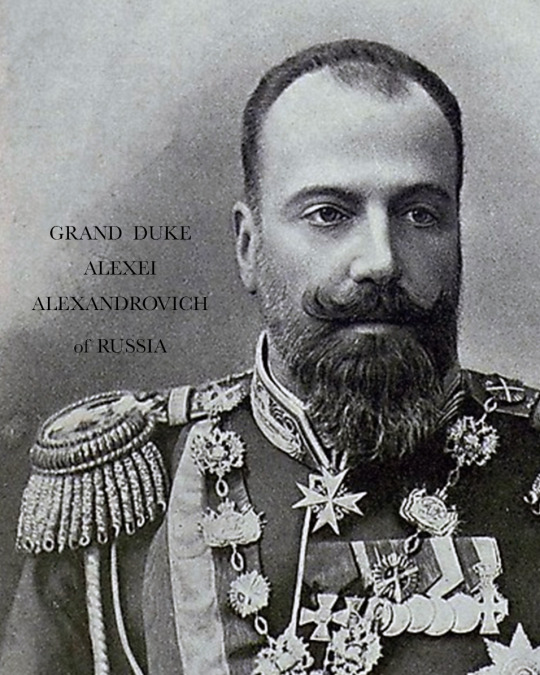

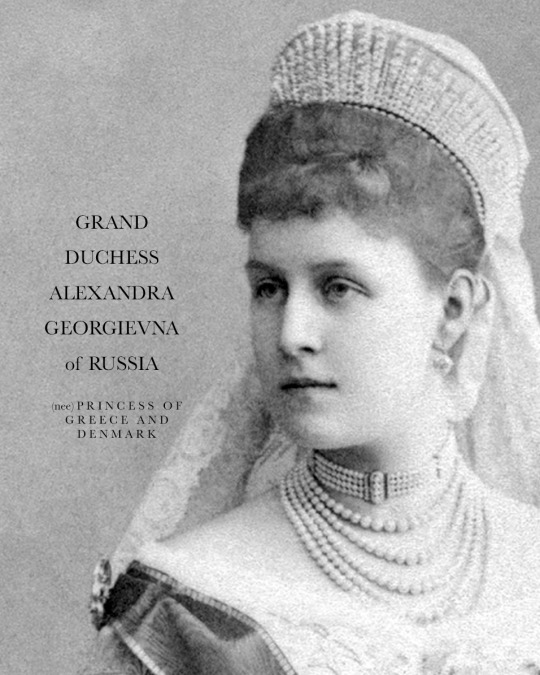
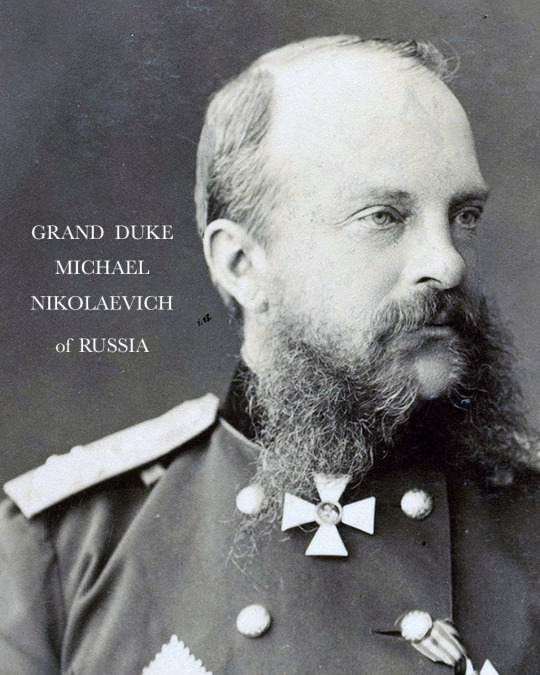



GODPARENTS OF PRINCE KONSTANTIN KONSTANTINOVICH
Prince Konstantin Konstantinovich was born on 1 January 1891 in Saint Petersburg, Imperial Russia. He was the third son and fourth child of Grand Duke Konstantin Konstantinovich of Russia and his German-born wife Grand Duchess Elizabeth Mavrikievna. Konstantin was christened on 3 January at 2 in the afternoon at Marble Palace Church, St. Petersburg, by the Confessor of Their Majesties. His godparents were:
ALEXANDER III, EMPEROR OF RUSSIA - his father’s first cousin was named as one of his many godparents. He was highly reactionary in domestic affairs and reversed some of the liberal reforms of his father, Alexander II. He was most likely present at his young cousin’s christening.
GRAND DUKE KONSTANTIN NIKOLAEVICH OF RUSSIA - his paternal grandfather and namesake was one of his numerous godparents. He was the Viceroy of Poland from 1862 to 1863. His real influence on internal affairs after 1868 was insignificant. He was reportedly absent at his grandson's christening, due to his ill health.
CHARLES ALEXANDER, GRAND DUKE OF SAXE-WEIMAR-EISENACH - his parents' distant cousin (as a grandson of Emperor Paul I of Russia) was also named as the young Konstantin's godparent. He was absent at the prince's christening. He was the penultimate ruler of Saxe-Weimar-Eisenach, from 1853 until his death in 1901.
QUEEN MARIE OF HANOVER - his great-aunt, the last Queen consort of Hanover, was amongst his numerous godparents. She was absent at his christening.
ELISABETH, GRAND DUCHESS OF OLDENBURG - another of his great-aunt named as his godmother. Elisabeth, upon her marriage to the Grand Duke of Oldenburg used the funds given to her by her father to set up the Elisabeth Foundation, which still exists today. Like her sister Queen Marie, she was absent at her great-nephew's christening.
GRAND DUKE ALEXEI ALEXANDROVICH OF RUSSIA - his father's illustrious first cousin was named as the prince's godfather. Chosen for a naval career, Alexei started his military training at an early age. By the age of 20 he had been appointed lieutenant of the Imperial Russian Navy, eventually becoming general-admiral.
GRAND DUCHESS ALEXANDRA PETROVNA OF RUSSIA - his great-aunt, the wife of Grand Duke Nicholas Nikolaevich, was another of his godmothers.A plain, and serious woman, her marriage to Grand Duke Nicholas was an unhappy one. Nevertheless, she would enjoy and maintain a good relationship with a few of her nephews including Emperor Alexander III and Grand Duke Konstantin Konstantinovich, who were sympathetic to her.
GRAND DUCHESS ALEXANDRA GEORGIEVNA OF RUSSIA - his paternal first cousin, the eldest daughter of King George I and Queen Olga, had been present and named as a godparent of Prince Konstantin, who was merely nineteen years her senior. In 1889, she married Grand Duke Paul Alexandrovich, the youngest brother of Emperor Alexander III.
GRAND DUKE MICHAEL NIKOLAEVICH OF RUSSIA - his great-uncle was also listed as his godparent, and had been present at the christening. A soldier for most of his adult life, he enjoyed a favourable relationship with the three last Emperors of Russia - his brother Alexander II; nephew Alexander III; and great-nephew Nicholas II.
GRAND DUKE PETER NIKOLAEVICH OF RUSSIA - his father's first cousin was another of his many godparents. He was the younger son of Grand Duke Nicholas Nikolaevich and his wife grand Duchess Alexandra Petrovna (also named as a godparent of Prince Konstantin, listed above).
PRINCESS AUGUSTA OF SAXE-MEININGEN - his maternal grandmother was also named as his godmother. In 1862, she married Prince Moritz of Saxe-Altenburg, and bore him five children.
PRINCESS LOUISE CHARLOTTE OF SAXE-ALTENBURG - his maternal aunt, the youngest sister of Grand Duchess Elizabeth Mavrikievna was amongst his numerous godparents. Both Louise Charlotte and her mother Augusta were absent at Konstantin's christening.
Source
48 notes
·
View notes
Text
My next post in support of Ukraine is:
Next site, Sokyrnytsia (Сокирниця) Church in Sokyrnytsia, Zakarpattia Oblast. It's also known as the Church of St. Nicholas. It dates from 1704. It was closed down at the end of WWII, and most of the icons were removed except for an image of St. Nicholas and one of the Virgin Mary. It wasn't until 1990 that services were restarted in the church, but those ended after a new Greek Catholic church was built next to it in 1997.
#StandWithUkraine
#СлаваУкраїні 🇺🇦🌻




10 notes
·
View notes
Text
As Reformation Day Approaches...
Many will wish to talk about Martin Luther. Which makes sense because he famously nailed the 95 theses to the church door at Wittenburg on October 31st.
But what better time to commemorate all of the OTHER important figures and reformers of the Protestant reformation? Of whom there were many.
Wikipedia lists 284 people burned in England under Queen Mary I, as she attempted to consolidate her power. Her new laws declared anyone teaching against Catholic doctrines to be guilty of heresy and subject to the death penalty. The Catholic church has never denounced these murders committed by its members on its behalf.
These laws affected famous and regular people alike. Over time I may make a series of posts with more detail about some of these persons.
Incomplete list of the protestant martyrs in England under the cut. Courtesy of Wikipedia.
Protestants executed under Mary I
1. John Rogers City of London clergyman – preacher, biblical translator, lecturer at St. Paul's Cathedral burnt 4 February 1555 Smithfield, London
2. Lawrence Saunders City of London clergyman – preacher, Rector of All Hallows Bread Street, London burnt 8 February 1555 Coventry, Warwickshire
3. John Hooper Gloucester and Worcester clergyman – Bishop of Gloucester and Worcester under Edward VI burnt 9 February 1555 Gloucester, Gloucestershire
4. Rowland Taylor Hadleigh, Suffolk clergyman – Rector of Hadleigh, Suffolk burnt 9 February 1555 Aldham Common, Nr Hadleigh, Suffolk[5]: p.98 [59]
5. Rawlins White Cardiff, Glamorgan fisherman burnt March 1555 Cardiff, Glamorgan[60]
6. Thomas Tomkins Shoreditch, London weaver burnt 16 March 1555 Smithfield, London[61]
7. Thomas Causton Horndon on the Hill or Thundersby, Essex gentleman burnt 26 March 1555 Rayleigh, Essex[62]
8. Thomas Higbed Horndon on the Hill or Thundersby, Essex gentleman burnt 26 March 1555 Horndon-on-the-Hill, Essex[62]
9. William Hunter Coleman Street Parish, London apprentice burnt 27 March 1555 (or 26 according to Foxe) Brentwood, Essex
10. Stephen Knight barber burnt 28 March 1555 Maldon, Essex[64]
11. William Pygot (or Pigot) butcher burnt 28 March 1555 Braintree, Essex[64]
12. [n 6] William Dighel burnt 28 March 1555 Banbury, Oxfordshire [65][66]
13. John Lawrence (or Laurence) clergyman – priest and former Blackfriar at Sudbury, Suffolk[50] burnt 29 March 1555 Colchester, Essex[64]
14. Robert Ferrar St David's, Pembrokeshire clergyman – Bishop of St David's under Edward VI burnt 30 March 1555 Carmarthen, Carmarthenshire[67]
15. George Marsh Dean, Lancashire clergyman – curate to Laurence Saunders and minister at Dean, Lancashire burnt 24 April 1555 Boughton, Cheshire[68]
16. William Flower Lambeth, London surgeon and teacher burnt 24 April 1555 Westminster[69]
17. John Cardmaker Wells, Somerset clergyman – prebendary of Wells Cathedral burnt 30 May 1555 Smithfield, London[70]
18. John Warne Walbrook, London upholsterer burnt 30 May 1555 Smithfield, London[70]
19. Thomas Hawkes (or Haukes) Essex gentleman burnt 10 June 1555 Coggeshall, Essex
20. Thomas Watts (or Wattes) Billericay, Essex linen draper burnt 10 June 1555 Chelmsford, Essex[7][72]
21. John Ardeley (or Ardite) Wigborough, Essex husbandman burnt 30 May 1555 (or 'about 10 June', according to Foxe) Rayleigh, Essex[7][73]
22. John Simson Wigborough, Essex husbandman burnt 30 May 1555 (or 'about 10 June', according to Foxe) Rochford, Essex[7][73]
23. Nicholas Chamberlain (or Chamberlaine) Coggeshall, Essex weaver burnt 14 June 1555 Colchester, Essex[7][74]
24. William Bamford (or Butler)[n 8]Coggeshall, Essex weaver burnt 15 June 1555 Harwich, Essex[7][74]
25. Thomas Ormond (or Osmande)[n 9]Coggeshall, Essex fuller burnt 15 June 1555 Manningtree, Essex[7][74]
26. John Bradford City of London clergyman – prebendary of St Paul's Cathedral burnt 1 July 1555 Smithfield, London[7][75][76]
27. John Leaf (or Jhon Least) Christ Church Greyfriars, London (born in Kirkby Moorside, Yorkshire) apprentice tallow chandler burnt 1 July 1555 Smithfield, London
Canterbury Martyrs of July 1555
28. John Bland (or Blande) Rolvenden, Kent clergyman – vicar of Rolvenden, Kent burnt 12 July 1555 Canterbury, Kent [7][78]
29. Nicholas Shetterden (or Shitterdun) burnt 12 July 1555 Canterbury, Kent
30. John Frankesh Adisham, Kent clergyman – parson of Adisham, Kent burnt 12 July 1555 Canterbury, Kent
31. Humphrey Middleton Ashford, Kent burnt 12 July 1555 Canterbury, Kent
32. Nicholas Hall Dartford, Kent bricklayer burnt 19 July 1555 Rochester, Kent
33. Christopher Wade Dartford, Kent linen-weaver burnt July 1555 Dartford, Kent
34. Margaret (or Margery) Polley Pepeling, Calais widow burnt 17 July 1555 Royal Tunbridge Wells, Kent[80]
35. Dirick Carver (also spelt Deryk; also known as Dirick Harman) Brighthelmstone (now Brighton), Sussex beer-brewer burnt 22 July 1555, Lewes, East Sussex
36. John Launder Godstone, Surrey husbandman burnt 23 July 1555 Steyning, West Sussex
37. Thomas Euerson (or Iueson, Iverson or Iveson) Godstone, Surrey carpenter burnt (day unknown) July 1555 Chichester, West Sussex
38. Richard Hook (or Hooke) lame man [66] burnt unknown date in July 1555 Chichester, West Sussex
39. James Abbess Stoke-by-Nayland, Suffolk shoemaker burnt 2 August 1555 Thetford, Norfolk (or Bury, according to Foxe)
40. John Denley Maidstone, Kent gentleman burnt 8 August 1555 Uxbridge, Middlesex
41. Robert Smith Windsor, Berkshire clerk at the college in Windsor, Berkshire and painter burnt 8 August 1555 Uxbridge, Middlesex
Canterbury Martyrs of August 1555
42. William Coker burnt 23 August 1555 Canterbury, Kent [7][89]
43. William Hopper Cranbrook, Kent[79] burnt 23 August 1555 Canterbury, Kent [7][89]
44. Henry Laurence burnt 23 August 1555 Canterbury, Kent [7][89]
45. Richard Collier (or Colliar) burnt 23 August 1555 Canterbury, Kent
46. Richard Wright Ashford, Kent[79] burnt 23 August 1555 Canterbury, Kent
47. William StereAshford, Kent[79] burnt 23 August 1555 Canterbury, Kent
48. Elizabeth Warne (or Warren)[n 13]Walbrook, London widow of John Warne, upholsterer burnt 23 August 1555 Stratford-atte-Bow, London
49. Roger Hues (aliases: Curryer, Corier) St Mary's, Taunton, Somerset burnt 24 August 1555 Taunton, Somerset [66][7][91]
50. George Tankerfield London (born in York) cook burnt 26 August 1555 St Albans
51. Patrick Pakingham (aliases: Packingham, Pachingham, Patchingham or Pattenham) burnt 28 August 1555 Uxbridge, Middlesex [7][87]
52. John Newman Maidstone, Kent pewterer burnt 31 August 1555 Saffron Walden, Essex [7][87]
53. Robert Samuel (or Samuell) Barfold, Suffolk clergyman – minister at Barfold, Suffolk burnt 31 August 1555 Thetford, Norfolk[7][93]
54. Stephen HarwoodWare, Hertfordshire brewer burnt 30 August 1555 Stratford in Essex[7][94]
55. Thomas Fust (or Fusse) hosier, August 1555 In the environs of London or Ware
56. William Hale (or Hailes)Thorpe, Essex, late August 1555 In the environs of Barnet, London
57. William Allen Somerton, Norfolk labourer burnt early September 1555 Walsingham, Norfolk
58. Roger Coe (or Coo or Cooe) Melford, Suffolk shearman burnt date unknown September 1555 Yoxford, Suffolk
59. Thomas CobHaverhill, Suffolk butcher burnt date unknown September 1555 Thetford, Norfolk
Canterbury Martyrs of September 1555
60. George Catmer (or Painter) Hythe, Kent burnt about 6 September 1555, according to Foxe (or 12 July 1555) Canterbury, Kent
61. Robert Streater (or Streter) Hythe, Kent burnt about 6 September 1555, according to Foxe (or 12 July 1555) Canterbury, Kent
62. Anthony Burward Calete (possibly Calais) [98] burnt about 6 September 1555, according to Foxe (or 12 July 1555) Canterbury, Kent
63. George Brodbridge (or Bradbridge) Bromfield, Kent burnt about 6 September 1555, according to Foxe (or 12 July 1555) Canterbury, Kent
64. James Tutty (or Tuttey)Brenchley, Kent burnt about 6 September 1555, according to Foxe (or 12 July 1555) Canterbury, Kent
65. Robert Glover (or Glouer)Mancetter, Warwickshire gentleman burnt 14 September 1555 Coventry, Warwickshire
66. Cornelius Bongey (or Bungey) capper burnt 20 September 1555 Coventry, Warwickshire
67. Thomas Hayward (or Heywarde) burnt mid September 1555 Lichfield, Staffordshire
68. John Goreway Holy Trinity Parish, Coventry, Warwickshire [50] burnt mid-September 1555 Lichfield, Staffordshire Ely Martyrs
69. William WolseyUpwell, Norfolk constable, one of the Ely Martyrs burnt 16 October 1555 Cathedral Green, Ely, Cambridgeshire
70. Robert Pygot (or Pigot) Wisbech, Isle of Ely, Cambridgeshire painter, also an Ely Martyr burnt 16 October 1555 Cathedral Green, Ely, Cambridgeshire
Oxford Martyrs
71. Hugh Latimer (or Latymer) Baxterley, Warwickshire [103] clergyman – chaplain to King Edward VI burnt 16 October 1555 outside Balliol College, Oxford
72. Nicholas RidleyFulham Palace clergyman – Bishop of London under Edward VI burnt 16 October 1555 outside Balliol College, Oxford
Canterbury Martyrs of November 1555
73. John Webbe (or Web) gentleman burnt 30 November 1555 Canterbury, Kent [7][105]
74. George Roper burnt 30 November 1555 Canterbury, Kent [7][105]
75. Gregory Parke (or Paynter)[citation needed] burnt 30 November 1555 Canterbury, Kent [7][105]
76. John PhilpotWinchester, Hampshire clergyman – Archdeacon of Winchester burnt 18 December 1555 Smithfield, London[7][106]
77. Thomas Whittle (or Whitwell)Essex clergyman – priest or minister burnt 27 January 1556 Smithfield, London[7][107]
78. Bartlett (or Bartholomew) GreenTemple, London – born in Basinghall, London gentleman and lawyer burnt 27 January 1556 Smithfield, London[7][107]
79. Thomas BrownSt Bride's parish, Fleet Street, London – born in Histon, Cambridgeshire burnt 27 January 1556 Smithfield, London[7][107]
80. John TudsonSt Mary Botolph parish, London – born in Ipswich, Suffolk artificer burnt 27 January 1556 Smithfield, London[7][107]
81. John Went (or Winter or Hunt) Langham, Essex artificer burnt 27 January 1556 Smithfield, London[7][107]
82. Isobella Forster (or Annis Foster) St Bride's parish, Fleet Street, London – Born in Greystoke, Cumberland wife of John Foster, cutler burnt 27 January 1556 Smithfield, London[7][107]
83. Joan Lushford (or Jone Lashforde, or Warne) Little Allhallows parish, Thames Street, London maid burnt 27 January 1556 Smithfield, London
Canterbury Martyrs of 1556
84. John Lomas (or Jhon Lowmas) Tenterden, Kent burnt 31 January 1556 Wincheap, Canterbury [7][108]
85. Annes Snoth (or Annis Snod) Smarden, Kent widow burnt 31 January 1556 Wincheap, Canterbury [7][108]
86. Anne Wright (or Albright); alias Champnes burnt 31 January 1556 Wincheap,Canterbury [7][108]
87. Joan (or Jone) SoaleHorton, Kent wife burnt 31 January 1556 Wincheap, Canterbury [7][108]
88. Joan Catmer Hythe, Kent 'wife (as it should seem) of George Catmer', burnt in 1555 burnt 31 January 1556 Wincheap, Canterbury [108][n 15][7]Ipswich Martyrs of 1556
89. Agnes Potten Ipswich, Suffolk wife of Robert Potten burnt 19 February 1556 Ipswich, Cornhill [7][n 16][109]
90. Joan Trunchfield Ipswich, Suffolk wife of Michael Trunchfield, a shoemaker burnt 19 February 1556 Ipswich, Cornhill
91. Thomas Cranmer Lambeth Palace clergyman – Archbishop of Canterbury (former) burnt 21 March 1556 outside Balliol College, Oxford[7][110]
92. John Maundrel Beckhampton, Wiltshire – brought up in Rowde, Wiltshire husbandman burnt 24 March 1556 outside Salisbury, Wiltshire
93. William Coberly Wiltshire tailor burnt 24 March 1556 outside Salisbury, Wiltshire
94. John Spicer (or Spencer) Winston, Suffolk[50] freemason or bricklayer burnt 24 March 1556 outside Salisbury, Wiltshire
95. John Harpole (or Hartpoole) St Nicholas Parish, Rochester, Kent burnt 1 April 1556 Rochester, Kent[7][112]
96. Joan BeachTunbridge Wells, Kent widow burnt 1 April 1556 Rochester, Kent
97. John Hullier (or Hulliarde) Babraham, Cambridgeshire clergyman – curate of Babraham, Cambridgeshire burnt 16 April 1556 Cambridge, Cambridgeshire
98. William Tyms (or Timmes)Hockley, Essex clergyman – curate of Hockley, Essex burnt 24 April 1556 Smithfield, London
99. Robert DrakeThundersley, Essex clergyman – minister or parson of Thundersley, Essex burnt 24 April 1556 Smithfield, London
100. Richard SpurgeBocking, Essex shearman burnt 24 April 1556 Smithfield, London[7][115]
101. Thomas SpurgeBocking, Essex fuller burnt 24 April 1556 Smithfield, London[7][115]
102. George AmbroseBocking, Essex fuller burnt 24 April 1556 Smithfield, London[7][115] 103. John Cavel (or Cauell)Bocking, Essex weaver burnt 24 April 1556 Smithfield, London[7][115]Colchester martyrs of April 1556
104. Christopher ListerDagenham, Essex husbandman burnt 28 April 1556 Colchester, Essex [7][116]
105. John MaceColchester, Essex apothecary burnt 28 April 1556 Colchester, Essex [7][116]
106. John SpencerColchester, Essex weaver burnt 28 April 1556 Colchester, Essex [7][116]
107. Simon Joyne sawyer burnt 28 April 1556 Colchester, Essex [116]
108. Richard NicolColchester, Essex weaver burnt 28 April 1556 Colchester, Essex
109. John HamondColchester, Essex tanner burnt 28 April 1556 Colchester, Essex [7][116]
110. Hugh Laverock (or Lauarocke) Barking, Essex painter, (a lame man) burnt 15 May 1556 Stratford in Essex
111. John Apprice (or Aprice) blind man burnt 15 May 1556 Stratford-Atte-Bow or Stratford in Essex
112. Thomas Drowry blind boy burnt about 15 May 1556 Gloucester, Gloucestershire [7][n 18][118]
113. Thomas Croker bricklayer burnt about 15 May 1556 Gloucester, Gloucestershire [7][n 18][118]
114. Katherine HutBocking, Essex widow burnt 16 May 1556 Smithfield, London[7][117]
115. Elizabeth ThackvelGreat Burstead, Essex maid burnt 16 May 1556 Smithfield, London[7][117]
116. Joan (or Jone) HornsBillericay, Essex maid burnt 16 May 1556 Smithfield, London
117. Thomas Spicer Winston, Suffolk labourer burnt 21 May 1556 Beccles, Suffolk
118. John Deny (or Denny) (possibly a female Joan or Jone) Beccles, Suffolk burnt 21 May 1556 Beccles, Suffolk
119. Edmund PooleBeccles, Suffolk burnt 21 May 1556 Beccles, Suffolk
120. Thomas HarlandWoodmancote, Sussex carpenter burnt 6 June 1556 Lewes, Sussex
121. John Oswald (or Oseward) Woodmancote, Sussex husbandman burnt 6 June 1556 Lewes, Sussex
122. Thomas Reed Ardingly, Sussex burnt about 6 June 1556 Lewes, Sussex
123. Thomas Avington (or Euington) Ardingly, Sussex turner burnt about 6 June 1556 Lewes, Sussex
124. Adam Forster (or Foster) Mendlesham, Suffolk husbandman burnt 17 June 1556 Bury St Edmunds, Suffolk [124][125]
125. Robert Lawson Mendlesham, Suffolk linen weaver burnt 17 June 1556 Bury St Edmunds, Suffolk [124][125]
126. Thomas Wood clergyman – pastor burnt about 20 June 1556 Lewes, Sussex
127. Thomas Milles Hellingly, Sussex burnt about 20 June 1556 Lewes, Sussex
128. Thomas Moor servant and husbandman burnt 26 June 1556 Leicester, Leicestershire
Stratford Martyrs, 11 men and 2 women.
129. Henry Adlington (or Addlinton) Grinstead, Sussex sawyer burnt about 27 June 1556 Stratford-Atte-Bow[7][126]
130. Lawrence (or Laurence) ParnamHoddesdon, Hertfordshire smith burnt about 27 June 1556 Stratford-Atte-Bow[7][126]
131. Henry WyeStanford-le-Hope, Essex brewer burnt about 27 June 1556 Stratford-Atte-Bow[7][126]
132. William Holywell (or Hallywell)Waltham Holy Cross, Essex, smith. burnt about 27 June 1556 Stratford-Atte-Bow
133. Thomas Bowyer (or Bowier)Great Dunmow, Essex weaver burnt about 27 June 1556 Stratford-Atte-Bow
134. George Searle White Notley, Essex tailor burnt about 27 June 1556 Stratford-Atte-Bow
135. Edmond Hurst St James's Parish, Colchester labourer burnt about 27 June 1556 Stratford-Atte-Bow[7][126]
136. Lion/Lyon Cawch City of London merchant/broker burnt about 27 June 1556 Stratford-Atte-Bow[7][126]
137. Ralph Jackson Chipping Ongar, Essex, serving-man burnt about 27 June 1556 Stratford-Atte-Bow[7][126]
138. John Derifall (or Dorifall) Rettendon, Essex labourer burnt about 27 June 1556 Stratford-Atte-Bow[7][126]
139. John Routh/Roth Wickes, Essex labourer burnt about 27 June 1556 Stratford-Atte-Bow
140. Elizabeth Pepper St James's parish, Colchester wife of Thomas Pepper, weaver burnt about 27 June 1556 Stratford-Atte-Bow
141. Agnes George West Barefold, Essex wife of Richard George, husbandman burnt about 27 June 1556 Stratford-Atte-Bow
142. Roger Bernard Framsden, Suffolk labourer burnt 30 June 1556 Bury St Edmunds, Suffolk [124][125]
143. Julins Palmer Reading, Berkshire schoolmaster burnt about 15 July 1556 'The Sand-pits', Nr Newbury, Berkshire
144. John Guin/Jhon Gwin shoemaker [66] burnt about 15 July 1556 'The Sand-pits', Nr Newbury, Berkshire[7][128]
145. Thomas Askin/Askue burnt about 15 July 1556 'The Sand-pits', Nr Newbury, Berkshire
Guernsey Martyrs – (Three women and one unborn male foetus)
146. Catherine Cauchés (sometimes spelt Katherine Cawches) St Peter Port, Guernsey, Channel Islands burnt 18 July 1556 St Peter Port, Guernsey, Channel Islands[129]
147. Perotine Massey (pregnant) St Peter Port, Guernsey, Channel Islands wife of NormanCalvinist minister burnt 18 July 1556 St Peter Port, Guernsey, Channel Islands[129]
148. Guillemine GilbertSt Peter Port, Guernsey, Channel Islands burnt 18 July 1556 St Peter Port, Guernsey, Channel Islands
149. Thomas Dungate (or Dougate) East Grinstead, Sussex burnt 18 July 1556 Grinstead, Sussex
150. John Forman (or Foreman) East Grinstead, Sussex burnt 18 July 1556 Grinstead, Sussex
151. Anne Tree (or Try) West Hoathly, Sussex burnt 18 July 1556 Grinstead, Sussex
152. Joan WasteAll Hallows', Derby, Derbyshire blind woman burnt 1 August 1556 Derby, Derbyshire
153. Edward Sharp glover (possibly)[66] burnt early September 1556 Bristol, Gloucestershire/Somerset
154. Rose Pencell burnt 17 October 1555 Bristol
155. William Shapton weaver burnt 17 October 1555 Bristol[131]
156. John Kurde Syresham, Northamptonshire shoemaker burnt October 1556 or 20 September 1557 Northampton, Northamptonshire
157. John Noyes Laxfield, Suffolk shoemaker burnt 22 September 1556 or 1557 [133]
158. Thomas Ravensdale burnt 24 September 1556 Mayfield, Sussex[85][122]
159. John Hart burnt 24 September 1556 Mayfield, Sussex [85][122]
160. Unknown man shoemaker burnt 24 September 1556 Mayfield, Sussex [85]
161. Unknown man currier burnt 24 September 1556 Mayfield, Sussex [85]
162. Nicholas Holden Withyham, Sussex weaver burnt 24 September 1556 Mayfield, Sussex
163. Unknown man carpenter burnt 25 September 1556 Bristol, Gloucestershire/Somerset
164. John Horn burnt late September 1556 Wotton-under-Edge, Gloucestershire
165. John Phillpott Tenterden, Kent burnt 16 January 1557 Wye, Ashford, Kent
166. Thomas Stephens Biddenden, Kent burnt 16 January 1557 Wye, Ashford, Kent
Canterbury Martyrs of January 1557
167. Stephen KempeNorgate, Kent burnt 15 January 1557 Canterbury, Kent [136]
168. William WatererBiddenden, Kent burnt 15 January 1557 Canterbury, Kent [136]
169. William ProwtingThurnham, Kent burnt 15 January 1557 Canterbury, Kent [136]
170. William LowickCranbrook, Kent burnt 15 January 1557 Canterbury, Kent [136]
171. Thomas HudsonSelling, Kent burnt 15 January 1557 Canterbury, Kent [136]
172. William HayHythe, Kent burnt 15 January 1557 Canterbury, Kent [136]
173. Nicholas Final Tenterden, Kent burnt 16 January 1557 Ashford, Kent
174. Martin Bradbridge Tenterden, Kent burnt 16 January 1557 Ashford, Kent
175. William Carman (or Carmen)[n 28] burnt day and month unknown 1557 [138]
176. Thomas Loseby burnt 12 April 1557 Smithfield, London
177. Henry Ramsey burnt 12 April 1557 Smithfield, London
178. Thomas Thyrtell (or Sturtle) burnt 12 April 1557 Smithfield, London
179. Margaret Hyde burnt 12 April 1557 Smithfield, London
180. Agnes Stanley (or Stanlye) burnt 12 April 1557 Smithfield, London
181. Richard Sharpe weaver burnt 7 May 1557 Cotham, Bristol[141]
182. Thomas Hale shoemaker burnt 7 May 1557 Cotham, Bristol[141]
183. Stephen Gratwick (or Steuen Grathwick) Brighthelmstone (now Brighton), Sussex burnt at end of May 1557 St. George's Fields, Southwark, Surrey
184. William Morant burnt at end of May 1557 St. George's Fields, Southwark, Surrey [7][142]: p. 272 [143]
185. Thomas King[66] burnt at end of May 1557 St. George's Fields, Southwark, Surrey
Maidstone martyrs
186. Joan (or Jone) Bradbridge Staplehurst, Kent Presumably a relative of Widow Bradbridge, burnt 19 June 1557[144] burnt 18 June 1557 Maidstone, Kent [7][145]
187. Walter Appleby Maidstone, Kent burnt 18 June 1557 Maidstone, Kent [7][145]
188. Petronil Appleby Maidstone, Kent wife of Walter Appleby burnt 18 June 1557 Maidstone, Kent [7][145]
189. Edmund Allin (or Allen) Maplehurst Mill, Frittenden, Kent miller burnt 18 June 1557 Maidstone, Kent [7][145]
190. Katherine Allin (or Allen) Maplehurst Mill, Frittenden, Kent Wife of Edmund Allin/Allen, miller burnt 18 June 1557 Maidstone, Kent [7][145]
191. Joan (or Jone) Manning Maidstone, Kent burnt 18 June 1557 Maidstone, Kent [7][145]
192. Elizabeth (surname possibly 'Lewis') blind maid burnt 18 June 1557 Maidstone, Kent [7][145]Canterbury martyrs of June 1557
193. John Fishcock/Jhon Fiscoke burnt 19 June 1557 Canterbury, Kent [7][145]
194. Nicholas White burnt 19 June 1557 Canterbury, Kent [7][145] 195. Nicholas Pardue/Perdue burnt 19 June 1557 Canterbury, Kent [7][145]
196. Barbara Final burnt 19 June 1557 Canterbury, Kent [7][145]
197. Bradbridge's Widow (Bradbridge's Wife) Probably Tenterden, Kent Probably the widow of Martin Bradbridge, burnt 16 January 1557 burnt 19 June 1557 Canterbury, Kent [145]
198. Mistress Wilson (also referred to as 'Wilson's Wife') burnt 19 June 1557 Canterbury, Kent [7][145]
199. Alice Benden, possibly also referred to as 'Benson's Wife' Staplehurst (or possibly Cranbrook), Kent[146] burnt 19 June 1557 Canterbury, Kent
Lewes Martyrs
200. Richard WoodmanWarbleton, Sussex iron-maker burnt 22 June 1557 Lewes, Sussex [7][82][147]
201. George Stevens (or Steuens) Warbleton, Sussex burnt 22 June 1557 Lewes, Sussex
202. William MainardMayfield, Sussex burnt 22 June 1557 Lewes, Sussex
203. Alexander HosmanMayfield, Sussex servant of William Mainard burnt 22 June 1557 Lewes, Sussex
204. Thomasina WoodMayfield, Sussex maidservant of William Mainard burnt 22 June 1557 Lewes, Sussex
205. Margery Morris (or Morice) Heathfield, Sussex burnt 22 June 1557 Lewes, Sussex
206. James Morris (or Morice) – son of Margery Heathfield, Sussex burnt 22 June 1557 Lewes, Sussex
207. Denis Burcis (or Burgis) Buxted, Sussex burnt 22 June 1557 Lewes, Sussex
208. Ann Ashdon (or Ashdown; also referred to as 'Ashdon's Wife') Rotherfield, Sussex burnt 22 June 1557 Lewes, Sussex
209. Mary Groves (also referred to as 'Gloue's Wife') Lewes, Sussex burnt 22 June 1557 Lewes, Sussex
210. Simon Miller (or Milner) Lynn, Norfolk burnt 13 July 1557 Norwich, Norfolk
211. Elizabeth Cooper St Andrew's Church, Norwich, Norfolk wife of a pewterer burnt 13 July 1557 Norwich, Norfolk [7](which calls her 'a woman')
212. George Egles/Eagles hung, drawn & quartered, August 1557 Chelmsford, Essex[7][150]Colchester Martyrs of August 1557
213. William BongeorSt Nicholas Parish, Colchester, Essex glazier burnt 2 August 1557 Colchester, Essex [151]
214. William Purchase (or Purcas) Bocking, Essex fuller burnt 2 August 1557 Colchester, Essex [151]
215. Thomas Benhote (or Benold) Colchester, Essex tallow-chandler burnt 2 August 1557 Colchester, Essex
216. Agnes Silverside (or Smith) Colchester, Essex widow burnt 2 August 1557 Colchester, Essex [151]
217. Helen (or Ellen) EwringColchester, Essex wife of John Ewring, miller burnt 2 August 1557 Colchester, Essex [151]
218. Elizabeth Folk Colchester, Essex 'young maiden' and servant burnt 2 August 1557 Colchester, Essex [151]
219. William Munt (or Mount)Much Bentley, Essex burnt 2 August 1557 Colchester, Essex
220. Alice Munt (or Mount) Much Bentley, Essex wife of William Munt (or Mount) burnt 2 August 1557 Colchester, Essex [151]
221. Rose Allen (or Allin) Much Bentley, Essex spinster, daughter of Alice Mount burnt 2 August 1557 Colchester, Essex [151]
222. John JohnsonThorpe, Essex labourer burnt 2 August 1557 Colchester, Essex [151]
223. Richard Crashfield Wymondham, Norfolk burnt 5 August 1557 Norwich, Norfolk[7] which records 'one at Norwich' in July[152]
224. Father Fruier burnt August 1557 Rochester, Kent[7][150]
225. Robert Stevenson burnt August 1557 Rochester, Kent[153]
226. Sister of George Eagles burnt August 1557 Rochester, Kent
227. Unknown Woman burnt August 1557 Rochester, Kent[7]
228. Agnes Prest Boyton, Cornwall Spinner burnt 15 August 1557 Southernhay, Exeter [154]
229. Thomas Benion weaver burnt 27 August 1557 Bristol[141]
230. Joyce Lewis Mancetter, Warwickshire gentlewoman burnt September 1557 Lichfield, Staffordshire – may be the same as Joyce Bowes, August 1557 (the Regester)
231. Ralph Allerton/Rafe Glaiton Much Bentley, Essex burnt 17 September 1557 Islington
232. James Austoo (or Auscoo) burnt 17 September 1557 Islington
233. Margery Austoo (or Auscoo) burnt 17 September 1557 Islington[7][157]
234. Richard Roth (or Rooth) burnt 17 September 1557 Islington
235. Agnes Bongeor (also known as Bowmer's Wife), wife of Richard Bongeor (similar name but different death date) burnt 17 September (or unknown date July) Colchester, Essex (or March 1558, Colchester)
236. Margaret Thurston/Widow Thurston-similar name but different death date burnt 17 September (or unknown date July) Colchester, Essex [132](or March 1558, Colchester)
237. Cicely Ormes St Edmund's Parish, Norwich, Norfolk wife of Edmund Ormes, worsted-weaver burnt 23 September 1557 Norwich, Norfolk
238. Thomas Spurdance servant of the Queen burnt November 1557 Bury St Edmunds, Suffolk
239. John Halingdale/Hallingdale/Hollingday carpenter burnt, 18 November/or day unknown October 1557, Smithfield, London
240. William Sparrow burnt, 18 November/or day unknown October 1557 Smithfield, London
241. Richard Gibson gentleman[66] burnt, 18 November/or day unknown October 1557 Smithfield, London
242. John Rough/Jhon Roughe London/Islington, Middlesex clergyman – minister at London/Islington, Middlesex burnt 22 December 1557 Smithfield, London
243. Margaret Maring (or Mering) burnt 22 December 1557 Smithfield, London
244. [Unknown forename ...] Lawton burnt March 1558 Huntingdon, Huntingdonshire
245. Cuthbert Symson/Symion London/Islington, Middlesex clergyman – deacon of the church in London/Islington, Middlesex died 28 March 1558 Smithfield, London
246. Hugh Foxe hosier[66] died 28 March 1558 Smithfield, London
247. John Devinish/Jhon Denneshe wool winder, died 28 March 1558 Smithfield, London
248. William Nichol burnt 9 April 1558 SM9515 Haverfordwest/Hwlffordd, Pembrokeshire/Sir Benfro
249. William Seaman (or Symon) Mendlesham, Suffolk husbandman burnt 19 May 1558 Norwich, Norfolk
250. Thomas Hudson Aylsham, Norfolk glover burnt 19 May 1558 Norwich, Norfolk[166] described as 'Glouer' in [7]
251. Thomas Carman[n 28] burnt 19 May 1558 Norwich, Norfolk
252. William Harris burnt 26 May 1558 Colchester[7][127]
253. Richard Day burnt 26 May 1558 Colchester, Essex [7][127]
254. Christian George (female) burnt 26 May 1558 Colchester, Essex her husband had previously been married to Agnes George, mentioned above
Islington Martyrs
255. Henry Pond (or Houde) burnt 27 June 1558 Smithfield, London
256. Reinald Eastland (or Launder) burnt 27 June 1558 Smithfield, London
257. Robert Southain (or Southam) burnt 27 June 1558 Smithfield, London
258. Matthew Ricarby (or Ricarbie) burnt 27 June 1558 Smithfield, London
259. John Floyd (or Flood) burnt 27 June 1558 Smithfield, London
260. John Holiday (or Hollyday) burnt 27 June 1558 Smithfield, London
261. Roger Holland London (taken in or near St John's Wood) merchant tailor burnt 27 June 1558 Smithfield, London
262. Sir Richard Yeoman (or Yeman) Hadleigh, Suffolk clergyman – curate of Hadleigh, Suffolk burnt 10 July 1558 Norwich, Norfolk
Islington Martyrs (second group)
263. Robert Mills burnt 14 July 1558 Brentford, Middlesex [167]
264. Stephen Cotton burnt 14 July 1558 Brentford, Middlesex
265. Robert Dynes burnt 14 July 1558 Brentford, Middlesex [167]
266. Stephen Wight (or Wreight) burnt 14 July 1558 Brentford, Middlesex
267. John Slade burnt 14 July 1558 Brentford, Middlesex
268. William Pikes (aliases: Pikas, Peckes) tanner burnt 14 July 1558 Brentford, Middlesex [7][167]
269. John Cooke sawyer burnt about 25 July 1558 Bury St Edmunds, Suffolk [170]
270. Robert Milles (or Plummer) shearman burnt about 25 July 1558 Bury St Edmunds
271. Alexander Lane wheelwright burnt about 25 July 1558 Bury St Edmunds, Suffolk
272. James Ashley bachelor burnt about 25 July 1558 Bury St Edmunds, Suffolk
273. Thomas Benbrike/Benbridge gentleman burnt unknown day in July 1558 Winchester, Hampshire
274. John (or Richard) Snell Bedale, Yorkshire burnt 9 September 1558 Richmond, Yorkshire
Ipswich Martyrs of 1558
275. Alexander Gooch (or Geche, or Gouch) Woodbridge or Melton, Suffolk weaver of shredding-coverlets burnt 4 November 1558 Ipswich Cornhill
276. Alice DriverGrundisburgh, Suffolk wife of a husbandman burnt 4 November 1558 Ipswich Cornhill [173]
277. Philip Humphrey (or Humfrey) burnt November 1558 Bury St Edmunds, Suffolk
278. John David/Jhon Dauy (brother of Henry David) burnt November 1558 Bury St Edmunds, Suffolk
279. Henry David/H. Dauy (brother of John David) burnt November 1558 Bury St Edmunds, Suffolk [174]Canterbury Martyrs of 1558
280. John CornefordWrotham, Kent burnt 15 November 1558 Canterbury, Kent [175]
281. Christopher Brown Maidstone, Kent burnt 15 November 1558 Canterbury[175]
282. John HerstAshford, Kent burnt 15 November 1558 Canterbury, Kent
283. Alice Snoth burnt 15 November 1558 Canterbury, Kent [175]
284. Katherine Knight/Tynley an aged woman burnt 15 November 1558 Canterbury
#english reformation#history#protestant#now you will see me open up about my study of the english reformation#protestant martyrs
65 notes
·
View notes
Text
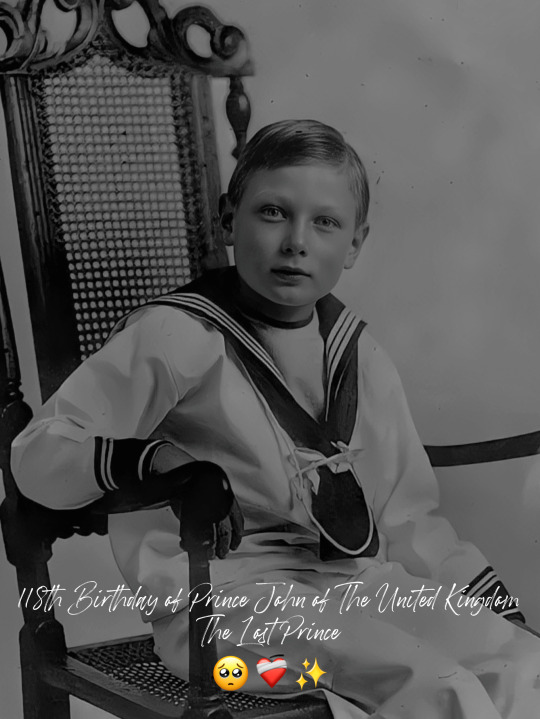
118 years ago on this day, Prince John of the United Kingdom, the youngest child of King George V and Queen Mary was born! He was named after his paternal uncle, Prince Alexander John, who died in infancy. John was said to be a bright, vibrant, healthy child in the first four years of his life. He was very cheeky and loved practical jokes, such as reportedly putting glue on door handles, and once famously referred to his father as the “ugly old man.” Above all, Prince John was part of an incredible royal dynasty. He was related to 20 reigning monarchs in Europe; his grandfather was King Edward VII, who reigned over an empire that was at its most powerful. But life wasn’t exactly easy for John and his siblings as they grew up under the incredibly strict guidance of their father, the future King George V, who was said to have put enormous pressure on his children to behave more like adults than children. “Lord Darby had a famous anecdote, that George V said to him ‘I was frightened of my father and I’m doing to make damn sure my children are frightened of me.’” Prince John's grandaunt the Dowager Empress of Russia wrote to her son Tsar Nicholas II that "George's children are very nice ... The little ones, George and Johnny are both charming and very amusing ..." In 1909, John began having seizures and was discovered to have epilepsy. When his condition deteriorated, he was kept away from the public eye and sent to live at Sandringham House, under the care of his nanny and governess, Charlotte Bill, known by the children as “Lala.” Apparently, all the children adored Lala, who had nursed them all as babies. In 1916, as his seizures became more frequent and severe, John was sent to live at Wood Farm, with "Lala" Bill having charge of his care. Though he maintained an interest in the world around him and was capable of coherent thought and expression, with his lack of educational progress, the last of his tutors was dismissed and his formal education ended. Physicians warned that he would likely not reach adulthood. His grandmother Queen Alexandra maintained a garden at Sandringham House especially for him and this became "one of the great pleasures of Prince John's life." After the summer of 1916, John was rarely seen outside the Sandringham Estate and passed solely into Lala Bill's care. After Queen Alexandra wrote that "Prince John is very proud of his house but is longing for a companion" Queen Mary broke from royal practice by having local children brought in to be playmates for Prince John. One of these was Winifred Thomas, a young girl from Halifax who had been sent to live with her aunt and uncle (who had charge of the royal stables at Sandringham) in hopes her asthma would improve. John's seizures intensified, and Bill later wrote "we dared not let him be with his brothers and sister, because it upsets them so much, with the attacks getting so bad and coming so often." He spent Christmas Day 1918 with his family at Sandringham House but was driven back to Wood Farm at night. On 18 January 1919, after a severe seizure, John died in his sleep at Wood Farm at 5:30 pm. Queen Mary wrote to Emily Alcock, an old friend that "for John it is a great relief, as his malady was becoming worse as he grew older, & he has thus been spared much suffering. I cannot say how grateful we feel to God for having taken him in such a peaceful way, he just slept quietly into his heavenly home, no pain no struggle, just peace for the poor little troubled spirit which had been a great anxiety to us for many years, ever since he was four years old"
She went on to add that "the first break in the family circle is hard to bear, but people have been so kind & sympathetic & this has helped us much." King George described his son's death simply as "the greatest mercy possible" On 20 January, the Daily Mirror said that "when the Prince John passed away his face bore an angelic smile"
John's funeral was at St Mary Magdalene parish church the funeral was attended by Sandringham House staff; "every single person on the estate went and stood around the gates and his grave was absolutely covered in flowers." Queen Alexandra wrote to Queen Mary that "now two darling Johnnies lie side by side" In her final mention of Prince John in her diary, Queen Mary wrote simply "miss the dear child very much indeed." Lala Bill always kept a portrait of Prince John above her mantelpiece, together with a letter from him that read "nanny, I love you."
97 notes
·
View notes
Text
Random saints by Sittow or Catherine of Aragon's parents?

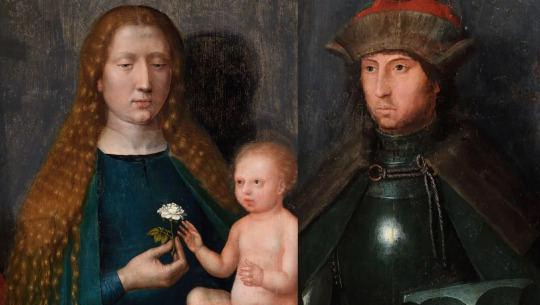
Read further if you wish to know what my theory is.
I first found this photo with mention it is by Sittow and at first I thought it is another portrait of Catherine. But quickly I realised this woman looks older and the features are not exactly the same.
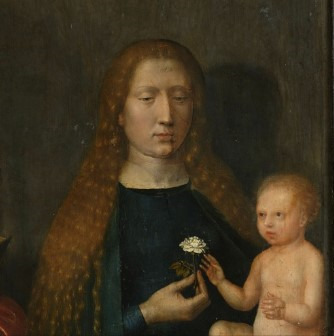
The nose is much narrower. And I started to wonder...we know that Sittow painted at least one portrait of Queen Isabella I of Castile.
And she had such nose. I could exclude possibility some of Catherine's sisters looked like this too, but women in that family tended to be very young-looking for really long.
So the age of sitter already is suggesting that it could be based upon Isabella towards end of her life. And it is also odd for depiction of Virgin Mary to depict woman who is not young...it is point in Isabella's favour.
While many claim Sittow painted Isabella in 1485, he was only born in 1468/1469 and didn't even become indipended master until at least 1488. He is first recorded working in Toledo in 1492. So he'd always be only able to depict Isabella over age of 40. And tbh, if this is her..then she looks great for somebody over 40!
But where is this image? It took me while to track down.
It's detail from wings of theThe Passion Altarpiece (Tallinn), its middle part is from c.1515-1520(with some 17th century additions) by different artist.

But I am not so sure how accurate is the dating of the outer wings by Sittow(1518-1525) which are in very different style, and might have originally belong to different altar middle.

If it is indeed 1518-1525 dating, then imo they are posthumous depictions based upon earlier sketches done from life. Sittow reusing those old sketches, using them as inspiration for his later work.
Link to photos only. Left pannel: https://artsandculture.google.com/asset/the-passion-altarpiece-outer-wing-with-the-virgin-mary-and-apostle-james-the-greater-paintings-of-the-outer-side-of-the-wings-by-michel-sittow-and-his-workshop/BwFnRG1v6gRqmQ
Right pannel: https://arthive.com/artists/75951~Michel_Sittow/works/526786~Saint_Adrian_and_Saint_Anthony
As to where they are located?
-Niguliste Museum(housed in former St. Nicholas' Church), which is part of Art Museum of Estonia(which combines collections from 3 other buildings+ this church). Hence in Tallin, Estonia but be aware there is over 3 km distance in between the church and other buildings.
But if anybody could go there and get us some pictures it'd be great (if it is allowed). Currently Niguliste Museum has exhibition about Sittow:

But back to the pannels. The left one depicts Madonna(Virgin Mary holding baby Jesus) and St. James the Great(apostle and patron saint of Spain:
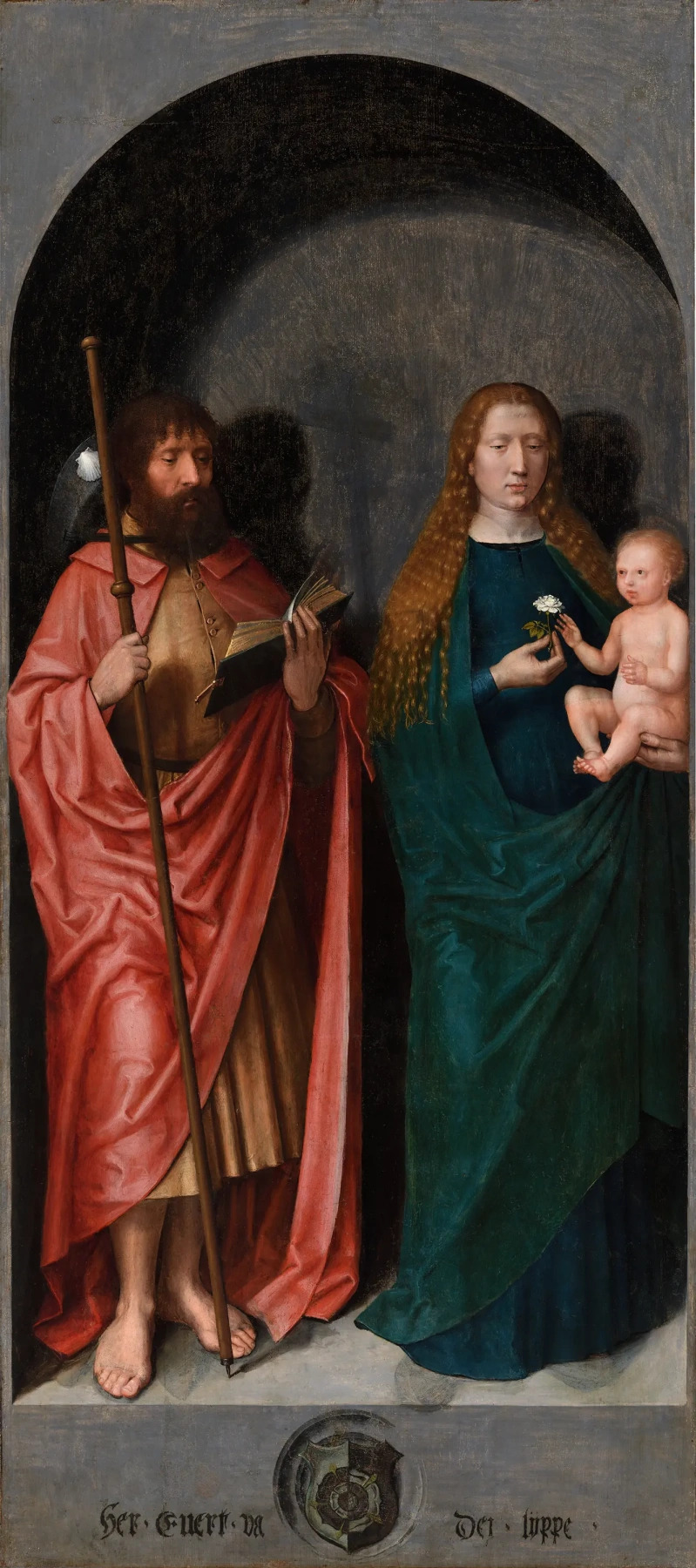
And please note that Tudor rose is combination of red and white rose and not always it was depicted as inner rose white, outer red. Sometimes they were halfed, with inner rose sometiems also switched.

Of course it could be some foreign coat of arms or later alteration.
Right pannel:

Here the coat of arms looks much newer and is probably altered(and if pomegranate turned out to be beneath it, I'd just die...)
The right pannel is depicting two male saints. On right is St Anthony the Great...was father of monasticism(of monastic life)...thus very important saint in christianity...
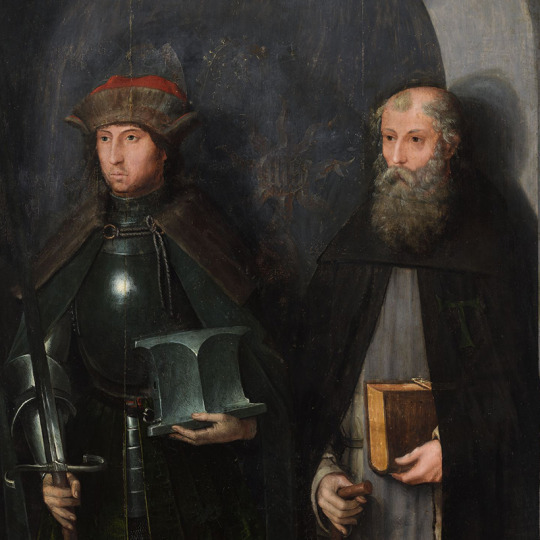
and on left St. Adrian of Nicomedia(2nd most popular military saint after St. George), and imo that's probably King Ferdinand II of Aragon:

It's not great likeness(brows not arched enough, looks bit slimmer, alla of nose not as defined), but overall it's enough of resemblence to not be able to exclude the possibility.
But if this is indeed done years after Sittow was in Spain...and he is reusing his old sketches of catholic monarchs to create this new religious scene(perhaps initially intended for them too, but never made into finished work before), then it is also possible that sketch done in pencil has partially rubbed off...and thus the differences in face of this male.
I think that if this was done while in Spain, such big differences are not very likely to occur. Not that pencil could not rub off, but I think Sittow would have noticed and cared about getting absolutely righ(to please his patrons) and thus would have corrected it.
Ehm, this kitty is supposed to be a lion:
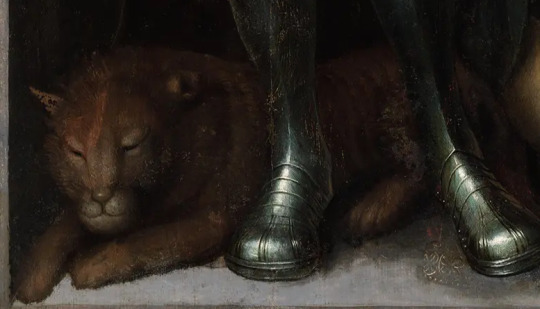
But you must be wondering, if Isabella indeed had this most vivid golden hair colour I always go on and on about, why does she have red hair here?
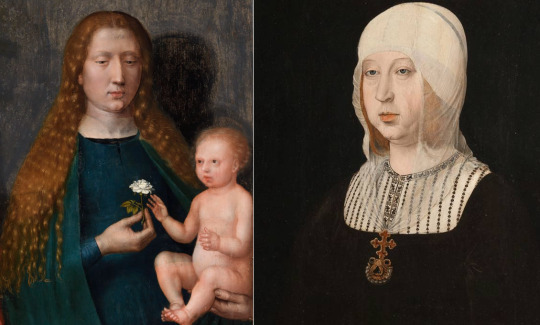
Several options to pick from: Pigments going wrong, Isabella's hair possibly turning to more reddish hues towards end of her life, or simply discoloured pinkish varnish which was very oddly applied...and on baby's skin you can see where somebody applied only one layer and where they went with brush for 2nd time.
If entire pannel has this varnish on, then it'd affect the hair, turning it more red. Why would such varnish not be removed? Sometimes money is tight and museums have multiple paintings to care for and those paintings in fairly good condition have to wait longer.
And sometimes it is not possible to remove discoloured varnish without harming the painting beneath.
Also worth of nothing is that Virgin Mary's dress is typically not teal, but vividly blue, the very best most expensive most vivid blue pigments were very often reserved for depicting the Virgin Mary:

Sometimes due to budget cost cheaper substitues were used, and those tend to fade.
Hence imo the colours originally might have been intended to be more like this(yes, I photoshopped it):

(I didn't change damn thing about male figure, just brightened it. But tbh I played with the woman's dress, skin and hair for while.)
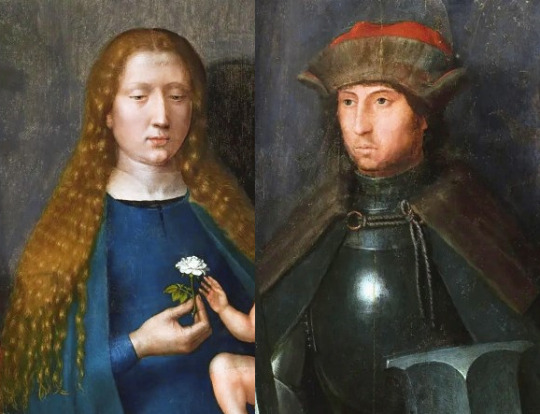
I mean if it looked like this now, fans of catholic monarchs would probably be all over it already.
But people overlook these dark slightly pinkish images located all the way in Estonia, even though it is atributed to Sittow himself!
(I don't mean people in Estonia, I mean people who search for Isabella's lost portrait by Sittow and stubbornly stuck to their favourite which is not even by Sittow!)

I honestly thought that people searching for lost portrait of Isabella by Sittow would have by now checked all his work, to see if perhaps she is there somewhere! Just doesn't look teen or young adult.
So I want you to be aware, if you're on quest of finding Isabella by Sittow's in that portrait with emerald necklace that this is imo the face you're looking for :
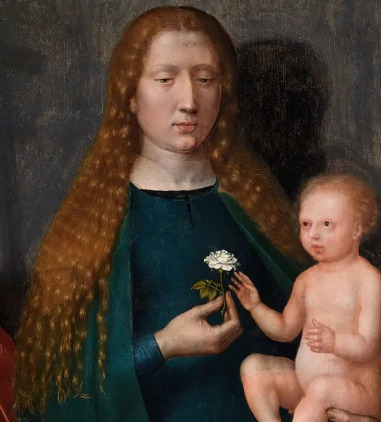
Possibly with hair bit more golden and skin more fair:
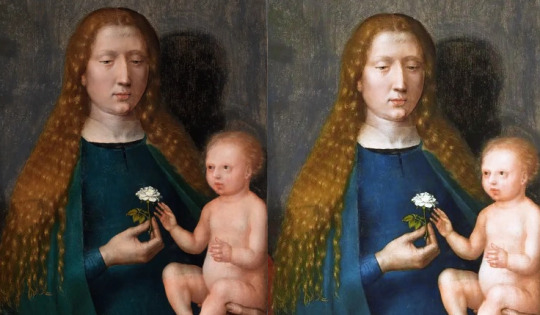
And it doesn't matter she doesn't look 20! She is still very beautiful.
Hence imo, these are Catherine of Aragon's parents, depicted in disguise of saints:

But I think they were likely painted years after Sittow left Spain, and his old sketches of them have been reused to create these pannels. I hope the experts will one day look more into this possibility.
I hope you've enjoyed this, and tell me what you think. Am I onto something or am I chasing shadows?

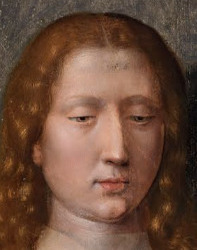
#historical portraits#isabella of castile#ferdinand of aragon#Isabella I of Castile#Ferdinand II of Aragon#sittow
78 notes
·
View notes
Text

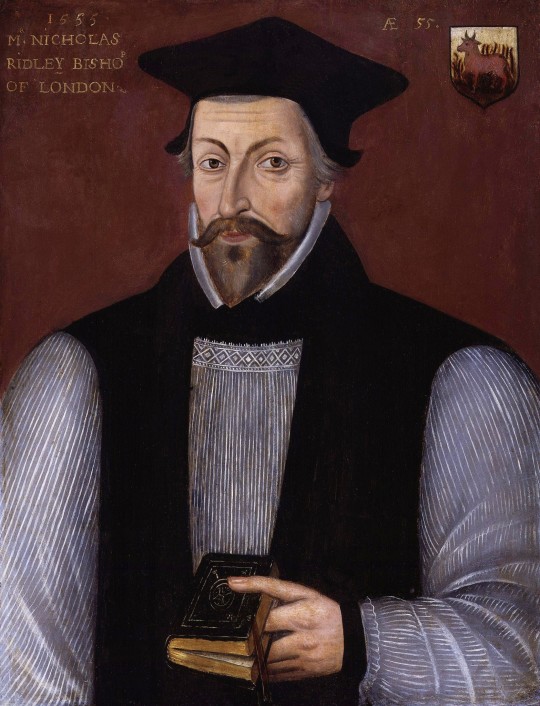


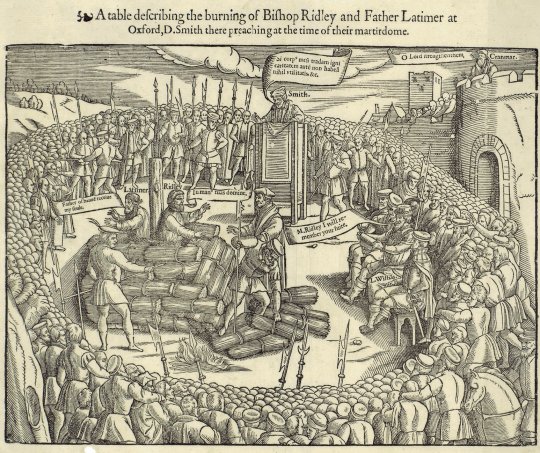
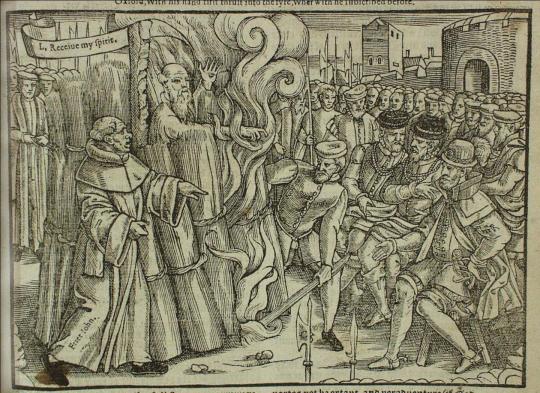
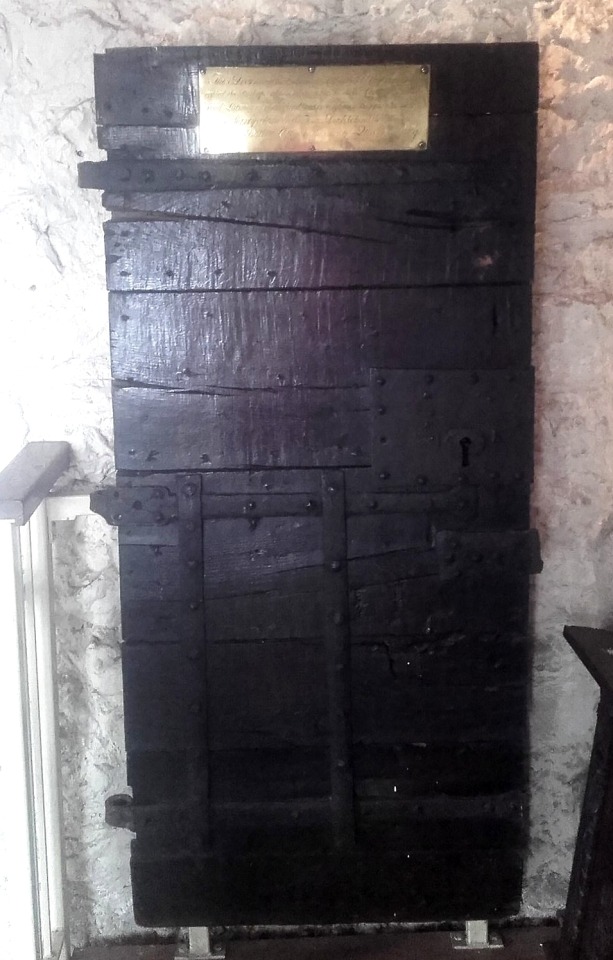
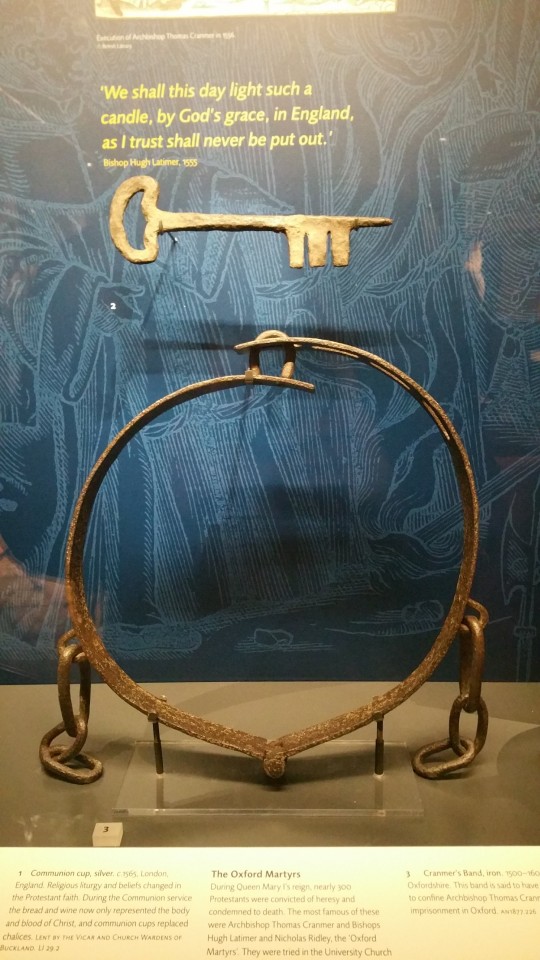
The 16th of October marks the commemoration by the Church of England of the Oxford Martyrs, Anglican bishops Nicholas Ridley, Hugh Latimer, and Thomas Cranmer, who were burned at the stake in Oxford for heresy under the reign of Mary I. Ridley and Latimer were burned together on that day in 1555; Cranmer's execution would be five months later.
They were some of the most high-profile figures executed during Mary's reign, having been respectively Bishop of London, Worcester, and Archbishop of Canterbury under the previous reign. They had also been singled out for their efforts to delegitimize Mary's claim to the throne; Cranmer had made the official pronouncement that annulled Henry VIII's marriage to Catherine of Aragon, thereby removing their daughter Mary from the line of succession, and Ridley had been instrumental in declaring Lady Jane Grey the successor to Edward VI, once again claiming Mary's illegitimacy.
The bishops made the most of the public spectacles of their executions, ensuring their legacy as religious martyrs. Latimer is quoted as having said "Be of good comfort, and play the man, Master Ridley; we shall this day light such a candle, by God's grace, in England, as I trust shall never be put out." Cranmer meanwhile had been pressured into signing a recantation of his Protestantism with a promise of leniency, but this was overruled by Mary herself, possibly because of her long-standing resentment of the role Cranmer has played in dissolving her parents' marriage. Once at the stake, Cranmer renounced his recantation, declared the Pope the Antichrist, and put his "unworthy hand" that had signed his presentation first into the fire.
Commemorations of the Martyrs can be found throughout Oxford; memorials are present in St. Mary's Church where the men were tried and convicted, the spot where the executions were held, and an ornate monument with statues of the three. The door to Cranmer's prison cell is preserved in the neighboring St. Michael's Church, and the Ashmolean Museum houses the key to the cell alongside the metal band said to have fastened Cranmer to the stake.
31 notes
·
View notes
Text
Generation 1 Family Recap
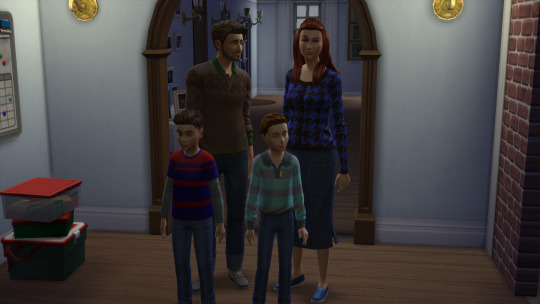
The founders, Johnathan and Laila Loomis, with their two youngest, Nicholas and Bryce.
Denomination: Irisite
Fundie Status: Full Fundie
Johnathan made a fortune as a writer, first of books and translations of the Book of the Watcher, then as a magazine writer for ETW. They have had 11 total blessings and will soon be entering elderhood.
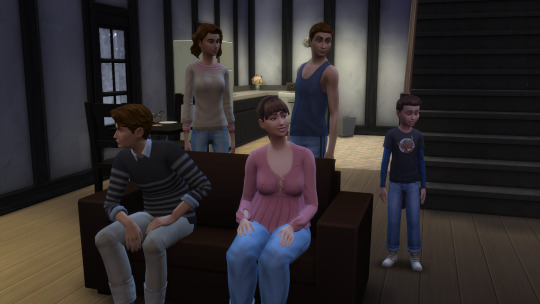
Danny and Iris Marsh with their three children, Isabel, Kenneth, and Antony.
Denomination: St. Cornelius
Fundie Status: Fundie-Lite
Iris is the eldest Loomis child and the oldest of the first set of twins. Danny manages to keep the family going in their small house, bringing home a decent income as an artist. Over a period of years the couple decided to do Natural Family Planning, as many in the church of St. Cornelius do, and have remained at three blessings. After a long moral battle, Iris also decided to start wearing pants.

Isla and Ezekiel Shearer, center, with four of their six children. On the left, twins Alana and Ryan, on the right twins Ratna and Shelley. Not pictured are their two eldest, Bo and Marjorie, who are not twins. Bo is currently rooming with his cousin Darin, Adam Loomis’ eldest son.
Denomination: Irisite
Fundie Status: Full Fundie
Isla is Iris’ twin sister and is married to Ezekiel, the eldest of the six Shearer children. Ezekiel works as a pastor at the Irisite church and they live on a modest middle class income. All Isla ever wanted was to have a big family, and she certainly got her wish. They are expected to have many more children in the future.

Chastity and Adam Loomis, here with six of their seven blessings. Back row, from left to right, Emilie, Major, Kory, Maya; front row, left to right, Avery and Caitlyn. Their eldest, Darin, is not pictured.
Denomination: Irisite
Fundie Status: Full fundie.
Adam is the eldest of the Loomis’ second pair of twins, and is married to Chastity, the eldest Shearer daughter. Adam has a temper and is constantly belittling both his wife and his children, many of whom are adopted. He works as a park ranger, which doesn’t pay enough for them to have a large or nice home, but they scrape by. They are also expected to have, or adopt, many more children.

Damien and Penny Franklin.
Denomination: Scleran
Fundie Status: Conservative
Penny is Adam Loomis’ twin sister. As a teenager she leveraged her marriage to Damien as a way to escape her family’s vision for her life, and converted to the Scleran church. She now works as a scientist at a leading lab. Despite how their relationship started, Penny and Damien have grown to truly love each other, though neither of them want children.

Adriana and Joshua Loomis.
Denomination: Scleran
Fundie Status: Conservative
Joshua is the eldest of the Loomis’ third set of twins. Adriana is the third daughter of the Moore family, who originally ran the Irisite Newcrest church. Joshua disliked what he saw of his parents religion in regards to his twin brother, James, and his sister Penny. After marrying Adriana they both converted to the Scleran church and are happily childless. Joshua currently works as a local representative, and Adriana as an art critic.

James Loomis and Jonah Shearer, with James’ younger sister, Maxine Loomis.
Denomination: None
Fundie Status: Ex-fundie
James (now Jamie) is Joshua’s twin brother. The night of his eighteenth birthday he and Jonah, the youngest of the Shearer children, eloped and ran away together to escape the homophobic Irisite church, each mutually deciding to leave religion entirely. Jamie is now a doctor at the San Myshuno hospital, and Jonah is part of a nonprofit, San My Pride. They are childless, though took in Jamie’s younger sister, Maxine (Max) after she was kicked out of the house by Johnathan Loomis. Since moving out Max has discovered that she is aromantic and asexual, and is developing her writing career.

Derek and Mary-Faith Loomis
Denomination: Eternal Teachings of the Watcher Megachurch, run by Geoffrey Landgraab.
Fundie Status: Full Fundie
Derek was the first singleton child of the Loomis family, and is married to the eldest daughter of the wealthy Landgraab family, who founded the ETW. Theirs was very much an arranged marriage, and they used Loomis family funds to purchase this large house where they’ll live until Derek inherits the Loomis family home. They are expected to have many children to uphold the image of the ETW, which they will do, if reluctantly. Derek currently works at a position in the magazine writing department of the ETW.
(A/N And that's a wrap on Gen 1! Thank you to everyone who has been following this story, and prepare for gen 2 with Mariah and Javi.)
#fundie simblr#fundie sims#fundie snark#gen 1#loomis family#modest sims#quiverfull sims#ts4#ts4 gameplay
8 notes
·
View notes
Text
The Death of Catherine Carey - 15 Jan 1569
On This Day (15 Jan) in 1569, Catherine Carey, Lady Knollys, Elizabeth I's cousin and Chief Lady of the Bedchamber, died at Hampton Court Palace, aged around 46 years old.

Catherine's husband, Sir Francis Knollys, had been sent north, initially to Carlisle, by Elizabeth in May 1568 to act as custodian for the recently captured Mary, Queen of Scots. Elizabeth had refused for Catherine to accompany him, not wanting to be parted from her cousin whom she had come to rely heavily on.
Catherine had fallen ill in the summer of 1568 with a fever; she had recovered, but there were concerns regarding the long-term health consequences of her multiple pregnancies (at least 15 in 18 years), and serving a demanding queen, who often did not reward those who had served her adequately. Her health deteriorated further when the court were at Hampton Court Palace for Christmas, and after being nursed in a Bedchamber next to the queen, died on 15 Jan 1569.

From Jul 1568, from when Francis first heard of Catherine's illness, he made repeated requests to be discharged from his duties, and return to court to care for his wife; his requests were repeatedly denied. He continued to make these requests up until 19 Jan 1569, as news of Catherine's death had not yet reached him.
Catherine's funeral was held at Westminster Abbey in Apr 1569, in a service funded by Elizabeth; following the service, she was interred in the floor in St Edmund's Chapel. A marble and alabaster monument was later erected above in memory of her.

Never having remarried, Francis died 37 years later in 1596; he is buried at St Nicholas's Church, Rotherfield Greys. However, his magnificent tomb depicts two effigies, of him and Catherine, lying side-by-side, surrounded by their children.

#tudor england#tudor history#tudor people#tudor#tudors#history#tudor women#elizabeth i#Catherine carey#francis knollys#Mary queen of scots#Hampton court palace#westminster abbey
3 notes
·
View notes
Text

"The Empress Marie Feodorvna, Alexander the Third’s consort, was a Danish Princess, and a sister of Queen Alexandra. She embraced the Orthodox Greek Church upon her marriage, and was a keen upholder of its traditions. I remember being terribly disillusioned by my first glimpse of the Empress. Childlike I had expected her to wear a golden crown, and the sight of her minus this Imperial ornament disappointed me bitterly. It was some time -before I could be consoled. The Empress was always very kind and gracious to the pupils of the Imperial Ballet, and when we performed in the Private Theatre at the Winter Palace, or at the Mariinsky Theatre, St. Petersburg, would reward us with boxes of chocolates and sweets.
Her Imperial Majesty had the most beautiful hands I have ever seen. They were so soft, and most delicately perfumed. We children regarded it as a special treat when we were allowed to kiss them, and we would surreptitiously inhale the fragrance of her delicious perfume as we did so. I have never smelt any perfume like it since, and my memories of the Empress Marie Feodorvna will always be associated with the exquisite garden-like fragrance that seemed to be wafted. with every movement she made. When she died in 1928, although she had left Russia nine years previously, there was a general feeling of grief throughout the Fatherland. She was a woman of remarkable energy, and she expended it in helping her husband and later her son, the Tsar Nicholas the Second, who was destined to be the last of the reigning House of Romanoff".
Lydia Kyasht "Romantic recollections"
3 notes
·
View notes
Text
Nah fuck off mate, I just saw Gray walking down the fucking street- isn't that dude supposed to be in Sydney?
also try guess my country using educational facts (because the fourth wall doesn't exist anymore):
It's a slavic country, located in eastern europe, known for it's unique cuisine and beautiful coastal beaches. It's quite a developed country, also known for it's reliable public transport, amazing literature (some boring, speaking from experience) and insanely smart people, for example Nicholas Copernicus.
It has pretty famous cities, with even more famous catholic churches, one of the most well-known being the St. Mary's Church in one of the countries oldest cities. It's a very catholic country and known to be pretty homophobic (rude 😒). They had one pope and there's a roundabout named in his honour not far from one of the countries cities that attracts the most tourists.
The country is also the home to many brilliant castles and stunning architecture, all from different time periods- which is actually really cool since say, people in the Renaissance era saw stuff that was built in the Baroque era and basically gave it a light academia upgrade.
Can you guess the country? I'm gonna be doing this till someone gets it then do that in every country I visit/ed
#carmen sandiego#carmen sandiego 2019#carmen sandiego netflix#carmen sandiego oc#guess the countryyyyy#please#i want people to appreciate that i just know these facts#lmao#i'm so lonely 😭#nah cos it started off with talking about gray and then abt my home country#yes it's my home country#thats also a clue#please guess guys
6 notes
·
View notes